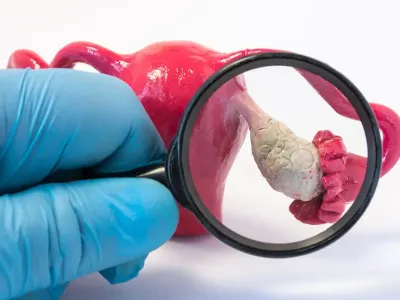
Are you concerned about the symptoms or transmission of Ureaplasma? Ureaplasma (ureaplasma urealyticum) is a term not widely known to many. Ureaplasma can affect the urogenital system, causing various symptoms and complications. In this article, you will find all the information you need to understand this infection and how to effectively protect yourself. Finally, we will answer the most common patient question: doctor, how does it go away?
Contents
What is Ureaplasma (ureaplasma urealyticum)
Ureaplasma is a bacterium considered "opportunistic." This means it can be found in both healthy individuals and those presenting symptoms.
Main Symptoms of Ureaplasma Infection
Although infection with the Ureaplasma bacterium is usually "innocuous," it can also cause various symptoms ranging from mildly annoying to severely debilitating.
Some women may experience:
- ✓ Heavy discharge
- ✓ Irritation
- ✓ Itching
- ✓ Pain during sexual intercourse
Ureaplasma infection can also cause:
- ✓ Inflammation of the urethra (urethritis)
- ✓ Burning sensation during urination
These symptoms, which may seem insignificant, can significantly impact quality of life and daily activity.
Ureaplasma Transmission - STD: How it is Transmitted and Who is at Risk
Ureaplasma (ureaplasma urealyticum) is primarily transmitted through sexual contact, regardless of gender or age. Sometimes, transmission occurs without contact, as Ureaplasma can be passed from mother to child during birth. Additionally, a study showed that Ureaplasma can survive for 2 hours in places like public toilets. However, this study did not prove that Ureaplasma can be transmitted from toilets. Finally, it is important to know that Ureaplasma in many women is part of the normal vaginal flora without causing symptoms.
Ureaplasma is primarily transmitted through sexual contact.
How Ureaplasma Diagnosis is Made
The diagnosis of Ureaplasma is made through various tests, such as vaginal culture or PCR. PCR is more reliable than traditional cultures because it can detect even small amounts of the bacterium with greater speed and accuracy. For women, this involves taking a sample from the vagina and/or cervix, which is then analyzed in the lab. Vaginal culture is also done to rule out other co-existing infections such as Mycoplasma and Chlamydia. Ureaplasma may appear in culture approximately 2 weeks after contact.
Do You Have Ureaplasma? Learn What to Do Now
How Does Ureaplasma Affect Fertility?
Ureaplasma can affect a woman's fertility if left untreated. It may cause issues such as pain, discharge, and infertility, cervicitis, salpingitis, threatened miscarriage, or preterm birth. These effects can have both emotional and physical impacts, which is why early diagnosis and treatment are crucial. In some cases, an infection with Ureaplasma can lead to inflammation or adhesions in the fallopian tubes, potentially requiring laparoscopy for diagnosis and restoration of the anatomical integrity of the reproductive organs.
Do you have questions about Ureaplasma or your symptoms? Don’t hesitate to contact me personally! Schedule an appointment now and receive the best possible care.
Is Ureaplasma Dangerous During Pregnancy?
While women without symptoms often do not need treatment to eradicate Ureaplasma, this is not the case during pregnancy. During pregnancy, Ureaplasma can increase the risk of certain conditions, such as premature rupture of membranes and preterm labor. Therefore, regular medical monitoring during pregnancy is vital, along with prompt treatment of any symptoms.

Pain and Itching in the Genital Area: What to Do
If you are experiencing pain, itching, or other uncomfortable symptoms in the genital area, it is important to consult a doctor. These symptoms could be indications of a Ureaplasma infection or some other form of vaginitis. Your doctor will be able to recommend appropriate treatment to minimize complications and address the potential infection. Do not ignore the symptoms and do not hesitate to seek help.
Prevention of Ureaplasma Infection: Tips and Preventive Measures
Using a condom during sexual intercourse can protect against the transmission of Ureaplasma. Also, it is important to get checked regularly, especially if you have symptoms or multiple partners. Prevention is always the best treatment, and the more informed you are, the more likely you are to avoid potential complications.
Treatment of Ureaplasma: Therapy Options
The most common question from patients is: how to get rid of it? Fortunately, there are various treatment options that can help you keep yourself and your loved ones safe. Antibiotics are the most common means of treatment, with doxycycline and azithromycin being the most common choices.
Treatment of Ureaplasma Infection
| Antibiotic | Dosage |
|---|---|
| Doxycycline | 100-mgX2, at least 7 days of treatment |
| Azithromycin | Single dose of 1-g |
| Tetracycline | Dosage varies |
| Clarithromycin | Dosage varies |
| Quinolones | Dosage varies |
However, treatment should not be limited to medication alone. Lifestyle changes, such as increasing the consumption of healthy foods, reducing stress, and practising safe sex, can be equally important for protection against infection.
The Partner and Ureaplasma: The Importance of Comprehensive Treatment
When a woman is diagnosed with ureaplasma (ureaplasma urealyticum), it is important to consider her partner's health. Since ureaplasma can be transmitted to men through sexual contact, if the partner does not receive treatment, it is likely to continue to transmit the infection, despite the treatment the woman is receiving.
The partner's treatment may include taking the same antibiotics as the woman, although this should always be done after medical advice. Also, the couple should avoid sexual contact until the treatment is completed and the eradication of the infection is confirmed.
Conclusion: The Importance of Being Informed About Ureaplasma
Ureaplasma is a type of bacteria that can be found in the genital organs of both men and women. It is considered a normal part of the human microbiome and is not strictly considered a sexually transmitted infection (STI). However, in some cases, it can cause infections such as urethritis, cervicitis, and pelvic inflammatory disease (PID), which are usually sexually transmitted.
Therefore, ureaplasma can be transmitted through sexual contact but is not considered a classic sexually transmitted disease (STD). It is more common among sexually active individuals, but can also be found in individuals who are not sexually active, which is why it is not classified as an STD.
Knowledge and understanding of ureaplasma infections can be vital for your reproductive health and well-being. With the right information and caution, you can protect yourself and your loved ones from ureaplasma (ureaplasma urealyticum) infection. It is always better to be prepared than to react, and information is the first and perhaps most important step.
Sources
- Bartkeviciene, D., Opolskiene, G., Bartkeviciute, A., Arlauskiene, A., Lauzikiene, D., Zakareviciene, J., & Ramasauskaite, D. (2020). The impact of Ureaplasma infections on pregnancy complications. The Libyan Journal of Medicine, 15(1), 1812821.
- Nagata, Y., Iwasaka, T., & Wada, T. (1979). Mycoplasma infection and infertility. Fertility and Sterility, 31(4), 392–395.
- https://emedicine.medscape.com/article/231470-medication
Συχνές Ερωτήσεις (FAQ)
Πηγές
- Bartkeviciene, D., Opolskiene, G., Bartkeviciute, A., Arlauskiene, A., Lauzikiene, D., Zakareviciene, J., & Ramasauskaite, D. (2020). The impact of Ureaplasma infections on pregnancy complications . The Libyan Journal of Medicine, 15(1), 1812821.
- Nagata, Y., Iwasaka, T., & Wada, T. (1979). Mycoplasma infection and infertility . Fertility and Sterility, 31(4), 392–395.
- https://emedicine.medscape.com/article/231470-medication
- https://www.journalofinfection.com/article/S0163-4453(13)00294-6/fulltext
- Potasman, I., Oren, A., & Srugo, I. (1999). Isolation of Ureaplasma urealyticum and Mycoplasma hominis from public toilet bowls . Infect Control Hosp Epidemiol, 20(1), 66–68. doi: 10.1086/501545. PMID: 9927273.









